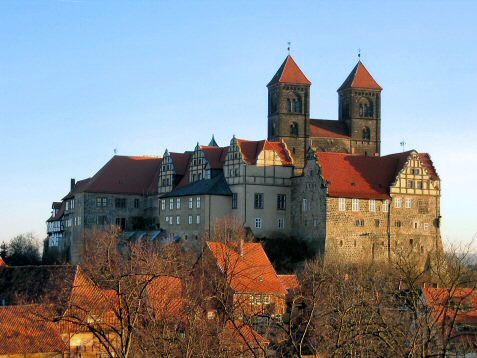
In the historic town centre, which extends over more than 80 hectares, the photographer's heart is happy. The most beautiful pictures are all already
available on the internet.
The closed medieval town plan and the huge stock of half-timbered houses of Quedlinburg document more than six centuries of half-timbered construction in a unique quality and
quantity.
The collegiate church of St. Servatius with its famous cathedral treasure, the thousand-year-old Wipertikirche church and the remains of St. Mary's monastery on Münzenberg are reminders of the priority this place had for the Ottonian rulers of the 10th century. The election of Henry, Duke of Saxony, as king in 919 laid the foundations for the emergence of the first German state. He was buried in his favourite palace on Quedlinburg's Schlossberg in 936. The women's monastery founded by his widow Mathilde in the same year developed into a high-ranking political and cultural metropolis of the empire. As the Easter palace of the Ottonian emperors and the site of important court days and synods, Quedlinburg was at the centre of events for more than 100 years.
In December 1994, the old town of Quedlinburg with its castle hill and collegiate church was inscribed by UNESCO on the list of the World and Natural Heritage of Humanity.

In search of Gertrud:
Whether Gertrud von Supplinburg was in Quedlinburg? Her first husband, Henry the Proud, had retreated to Quedlinburg in his duchy of Saxony to organise resistance against
the king. He probably took his family, Gertrud and son Heinrich with him.
Henry the Proud was a contender for the German royal throne. But things turned out differently. The Staufer Conrad III was elected. Henry the Proud delivered the imperial insignia, but refused to surrender one of the duchies. He was therefore ostracised by Conrad III. At a Diet in Würzburg in August 1138 he was denied Saxony, and in December of the same year in Goslar he was also denied Bavaria. Saxony was given to Albrecht the Bear, Bavaria to the Babenberg Margrave Luitpold IV in the spring of 1139.
Henry the proud had still power and he still had a retinue, an army. He drove Albrecht away very quickly.
Suddenly, on 20 October 1139, the 31-year-old Henry the Proud died in Quedlinburg. Very strange! He was probably poisoned. Poor Gertrud! She must have travelled with her underage son to her mother in Königslutter. The body of Henry the Proud was also brought to Königslutter. He was buried there in the cathedral next to his father-in-law Emperor Lothar.
Gertrud's burial place is not in Quedlinburg.